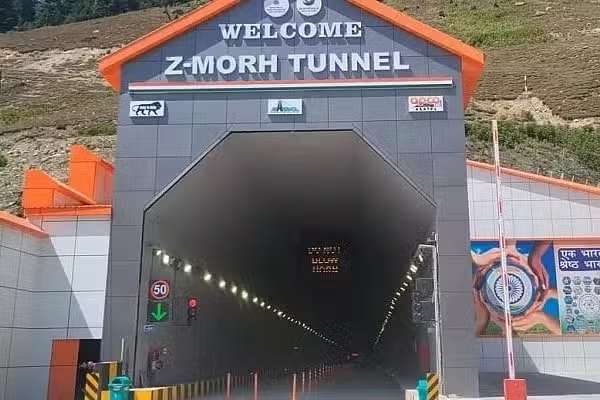
The Z-Morh Tunnel is a significant infrastructure project located in the union territory of Jammu & Kashmir. It is part of the broader efforts by the Government of India to improve connectivity and accessibility to the Kashmir region, particularly the strategic areas near Sonamarg and beyond. Named after the famous “Z” shape of the road that runs through the region, the tunnel will play a vital role in boosting tourism, regional development, and defense preparedness.
Key Features of the Z-Morh Tunnel
- Location:
- The Z-Morh Tunnel is situated on the Srinagar-Sonamarg-Gumri Road (NH-1D) in the Ganderbal district of Jammu & Kashmir.
- It lies approximately 20 km from Sonamarg and about 60 km from Srinagar.
- Length and Structure:
- The Z-Morh Tunnel is 6.5 kilometers long.
- It includes a two-lane main tunnel along with a parallel escape tunnel for emergencies.
- All-Weather Connectivity:
- The tunnel ensures all-weather connectivity to Sonamarg, a popular tourist destination that remains cut off during the winter due to heavy snowfall.
- The Z-Morh Tunnel will allow year-round access to the region, boosting local livelihoods and tourism.
- Construction and Design:
- Built using modern tunneling methods, the project incorporates New Austrian Tunneling Method (NATM), ensuring safety and stability.
- The tunnel is equipped with advanced ventilation systems, fire-fighting systems, and intelligent traffic management systems.
- Emergency Preparedness:
- A parallel escape tunnel has been built alongside the main tunnel to facilitate evacuation in case of emergencies.
- It has been designed to handle challenges like landslides, snow avalanches, and seismic activity.
- Cost and Funding:
- The project is being executed at an estimated cost of around ₹2,300 crores.
- It is funded under the Bharatmala Pariyojana, a flagship program of the Indian government aimed at improving highway infrastructure.
- Executing Agencies:
- The project is being executed by the National Highways and Infrastructure Development Corporation Limited (NHIDCL).
- The contractor for the project is APCO Infratech Pvt. Ltd.
- Timeline:
- The project started in 2015 and faced several delays due to terrain challenges, climatic conditions, and logistical issues.
- The Z-Morh Tunnel is expected to be operational by early 2025.
Strategic Importance
- Defense Preparedness:
- The tunnel is crucial for the movement of troops and logistics to Ladakh and nearby areas, which have strategic importance due to their proximity to international borders.
- Tourism Boost:
- The tunnel will allow tourists year-round access to Sonamarg, which is known for its scenic beauty and proximity to destinations like Amarnath and Zoji La Pass.
- Economic Growth:
- Improved connectivity will enable local businesses to thrive by making it easier to transport goods and materials to and from the region.
- Connectivity to Zoji La Pass:
- The Z-Morh Tunnel is part of a larger project that includes the Zoji La Tunnel, which will connect Sonamarg with Leh, providing an all-weather route between Srinagar and Ladakh.
Challenges in Construction
- Terrain and Climate:
- The region’s rugged terrain and extreme weather posed significant challenges during the construction process.
- Heavy snowfall and landslides disrupted progress multiple times.
- Geological Issues:
- The construction had to deal with unstable rock formations and water seepage, which required careful engineering and planning.
- Delayed Timelines:
- Initial delays were caused by the complex terrain, followed by administrative and funding hurdles.
Benefits of the Z-Morh Tunnel
- Year-Round Connectivity:
- The tunnel ensures that Sonamarg remains accessible even during harsh winters, benefitting locals, tourists, and military operations.
- Enhanced Tourism:
- With uninterrupted access to Sonamarg and nearby destinations, the region is likely to see a significant boost in tourist inflows.
- Economic Opportunities:
- Improved connectivity will lead to better trade opportunities for locals, especially for those involved in handicrafts, agriculture, and tourism-related businesses.
- Defense and Strategic Gains:
- The tunnel enhances the Indian Army’s ability to maintain and mobilize resources in the region.
Future Scope
The Z-Morh Tunnel is a stepping stone in the government’s broader plan to improve connectivity across Jammu & Kashmir and Ladakh. Alongside the Z-Morh Tunnel, the construction of the Zoji La Tunnel, the world’s longest bi-directional tunnel, will further enhance connectivity between Srinagar and Leh. Together, these projects will transform the socio-economic landscape of the region.
Conclusion
The Z-Morh Tunnel is a game-changing infrastructure project for Jammu & Kashmir. By providing all-weather connectivity, it will significantly improve the lives of the local population, boost tourism, and strengthen India’s defense and strategic capabilities. Its successful completion will serve as a testament to India’s engineering and logistical prowess in challenging terrains.




